 Backend Development
Backend Development PHP Tutorial
PHP Tutorial How to develop best practices for defending against replay attacks using PHP and Vue.js
How to develop best practices for defending against replay attacks using PHP and Vue.jsHow to use PHP and Vue.js to develop best practices for defending against replay attacks
Replay attack (Replay Attack) is a common network security threat. Attackers intercept and repeatedly send network requests. to trick the system. To defend against this attack, developers should adopt some best practices to secure their applications. This article will describe how to develop best practices for defending against replay attacks using PHP and Vue.js, and provide some code examples.
-
Use random token (Random Token)
In each request interacted between the client and the server, use a randomly generated token to verify the legitimacy of the request . The client sends this token with every request, and the server checks whether the token is valid after receiving the request. This ensures that each request is unique and cannot be reused.In PHP, you can use the
uniqid()function to generate a unique token. The sample code is as follows:<?php // 生成随机令牌 $token = uniqid(); // 将令牌存储到会话中 $_SESSION['token'] = $token; ?>
In Vue.js, you can use the
axioslibrary to send HTTP requests and add a token to each request. The sample code is as follows:// 获取令牌 const token = sessionStorage.getItem('token'); // 发送请求时添加令牌 axios.post('/api/endpoint', { data }, { headers: { 'X-CSRF-Token': token, }, }); -
Using timestamp (Timestamp)
In addition to using random tokens, timestamps can also be used to verify the validity of the request. Add a timestamp to each request, and the server can determine whether the request has expired based on the timestamp value. If the requested timestamp is too different from the current time, the server can reject the request.In PHP, you can use the
time()function to get the current timestamp. The sample code is as follows:<?php // 获取当前时间戳 $timestamp = time(); // 将时间戳存储到会话中 $_SESSION['timestamp'] = $timestamp; ?>
In Vue.js, you can use the
Date.now()method to get the current timestamp. The sample code is as follows:// 获取当前时间戳 const timestamp = Date.now(); // 发送请求时添加时间戳 axios.post('/api/endpoint', { data, timestamp }); -
Encrypt Data (Encrypt Data)
When transmitting sensitive data, using encryption algorithms to encrypt the data can improve security. By using a symmetric encryption algorithm such as AES, the client can encrypt the data before sending the request to the server, and the server can decrypt the data and process it after receiving the request.In PHP, you can use the
openssl_encrypt()andopenssl_decrypt()functions for data encryption and decryption. The sample code is as follows:<?php // 加密数据 $encryptedData = openssl_encrypt($data, 'AES-128-CBC', $key, OPENSSL_RAW_DATA, $iv); // 解密数据 $decryptedData = openssl_decrypt($encryptedData, 'AES-128-CBC', $key, OPENSSL_RAW_DATA, $iv); ?>
In Vue.js, you can use the
CryptoJSlibrary for data encryption and decryption. The sample code is as follows:// 加密数据 const encryptedData = CryptoJS.AES.encrypt(data, key, { iv }); // 解密数据 const decryptedData = CryptoJS.AES.decrypt(encryptedData, key, { iv });The above are some best practices and code examples for developing defense against replay attacks using PHP and Vue.js. By taking these security measures, developers can effectively protect applications from the threat of replay attacks. However, it is important to note that in addition to these basic measures, other security measures should be taken based on specific application needs to improve application security.
The above is the detailed content of How to develop best practices for defending against replay attacks using PHP and Vue.js. For more information, please follow other related articles on the PHP Chinese website!
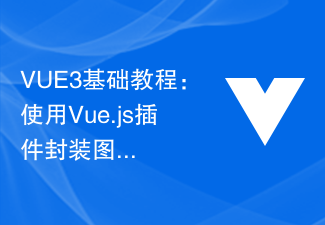 VUE3基础教程:使用Vue.js插件封装图片上传组件Jun 15, 2023 pm 11:07 PM
VUE3基础教程:使用Vue.js插件封装图片上传组件Jun 15, 2023 pm 11:07 PMVUE3基础教程:使用Vue.js插件封装图片上传组件Vue.js是一款流行的前端框架,它使开发者可以用更少的代码创建更高效、灵活的应用程序。尤其是在Vue.js3发布之后,它的优化和改进使得更多的开发者倾向于使用它。这篇文章将介绍如何使用Vue.js3来封装一个图片上传组件插件。在开始之前,需要先确保已经安装了Vue.js和VueCLI。如果尚未安装
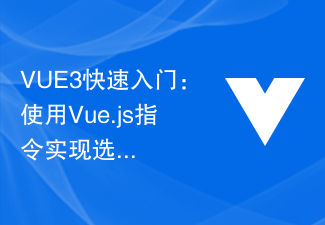 VUE3快速入门:使用Vue.js指令实现选项卡切换Jun 15, 2023 pm 11:45 PM
VUE3快速入门:使用Vue.js指令实现选项卡切换Jun 15, 2023 pm 11:45 PM本文旨在帮助初学者快速入手Vue.js3,实现简单的选项卡切换效果。Vue.js是一个流行的JavaScript框架,可用于构建可重用的组件、轻松管理应用程序的状态和处理用户界面的交互操作。Vue.js3是该框架的最新版本,相较于之前的版本变动较大,但基本原理并未改变。在本文中,我们将使用Vue.js指令实现选项卡切换效果,目的是让读者熟悉Vue.js的
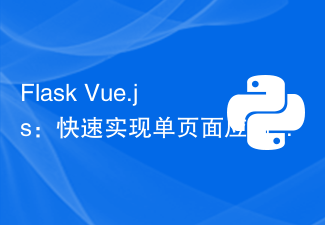 Flask + Vue.js:快速实现单页面应用Jun 17, 2023 am 09:06 AM
Flask + Vue.js:快速实现单页面应用Jun 17, 2023 am 09:06 AM随着移动互联网和Web技术的迅速发展,越来越多的应用需要提供流畅、快速的用户体验。传统的多页面应用已经无法满足这些需求,而单页面应用(SPA)则成为了解决方案之一。那么,如何快速实现单页面应用呢?本文将介绍如何利用Flask和Vue.js来构建SPA。Flask是一个使用Python语言编写的轻量级Web应用框架,它的优点是灵活、易扩
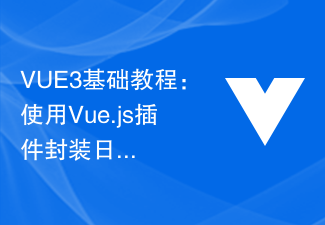 VUE3基础教程:使用Vue.js插件封装日历组件Jun 15, 2023 pm 09:09 PM
VUE3基础教程:使用Vue.js插件封装日历组件Jun 15, 2023 pm 09:09 PMVue.js是现代化的前端JavaScript框架之一,它提供了一套完整的工具来构建交互式用户界面。在Vue.js的生态系统中,有各种各样的插件和组件,可以大大简化我们的开发流程。在本篇文章中,我们将介绍如何使用Vue.js插件封装一个日历组件,以方便我们在Vue.js项目中快速使用。Vue.js插件Vue.js插件可以扩展Vue.js的功能。它们可以添加全
 Vue.js实现登录验证的完整指南(API、JWT、axios)Jun 09, 2023 pm 04:04 PM
Vue.js实现登录验证的完整指南(API、JWT、axios)Jun 09, 2023 pm 04:04 PMVue.js是一种流行的JavaScript框架,用于构建动态Web应用程序。实现用户登录验证是开发Web应用程序的必要部分之一。本文将介绍使用Vue.js、API、JWT和axios实现登录验证的完整指南。创建Vue.js应用程序首先,我们需要创建一个新的Vue.js应用程序。我们可以使用VueCLI或手动创建一个Vue.js应用程序。安装axiosax
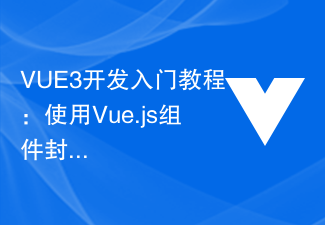 VUE3开发入门教程:使用Vue.js组件封装chart图表Jun 15, 2023 pm 10:29 PM
VUE3开发入门教程:使用Vue.js组件封装chart图表Jun 15, 2023 pm 10:29 PM随着大数据时代的到来,数据可视化已经成为了现如今的趋势之一。在Web前端开发的过程中,如何使用Vue.js进行数据可视化处理,成为了许多前端开发者所关注的问题。本文将会介绍如何使用Vue.js组件,封装基于chart.js库的图表。1.了解chart.jsChart.js是一款基于HTML5CanvasElement的简单易用、跨平台的开源图表库,我们可
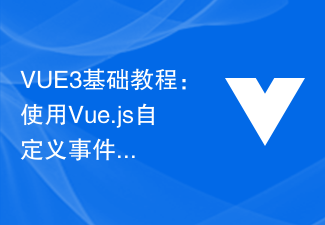 VUE3基础教程:使用Vue.js自定义事件Jun 15, 2023 pm 09:43 PM
VUE3基础教程:使用Vue.js自定义事件Jun 15, 2023 pm 09:43 PMVue.js是一款流行的JavaScript框架,它提供了很多方便的特性,所以它在开发Web应用程序时非常有用。Vue.js中的自定义事件系统使其更加灵活,并且可以通过组件事件触发和处理来实现更好的代码重用性。在本文中,我们将讨论如何使用Vue.js的自定义事件。Vue.js中自定义事件的基础在Vue.js中,我们可以通过v-on指令来监听DOM事件。例如,
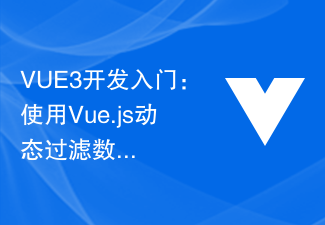 VUE3开发入门:使用Vue.js动态过滤数据列表Jun 15, 2023 pm 09:10 PM
VUE3开发入门:使用Vue.js动态过滤数据列表Jun 15, 2023 pm 09:10 PMVue.js已经成为现代Web开发的中流砥柱。它是一个轻量级的JavaScript框架,提供了数据绑定和组件化的能力,使得开发者能够更加轻松地构建交互型应用程序。而现在,Vue.js的新版本VUE3也已经面世。在本文中,我们将使用VUE3,通过实例,介绍如何在Vue.js中实现动态过滤数据列表。1.准备工作在开始本教程之前,您需要先安装Node.js和Vue


Hot AI Tools

Undresser.AI Undress
AI-powered app for creating realistic nude photos

AI Clothes Remover
Online AI tool for removing clothes from photos.

Undress AI Tool
Undress images for free

Clothoff.io
AI clothes remover

AI Hentai Generator
Generate AI Hentai for free.

Hot Article

Hot Tools

SublimeText3 English version
Recommended: Win version, supports code prompts!

VSCode Windows 64-bit Download
A free and powerful IDE editor launched by Microsoft

MantisBT
Mantis is an easy-to-deploy web-based defect tracking tool designed to aid in product defect tracking. It requires PHP, MySQL and a web server. Check out our demo and hosting services.

WebStorm Mac version
Useful JavaScript development tools

EditPlus Chinese cracked version
Small size, syntax highlighting, does not support code prompt function




